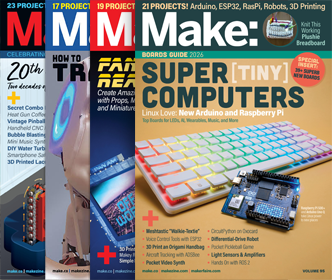
No-Sew T-Shirt Tote Bag
20-30 min
Ages 8+
What Will You Learn?
What can you make from an old t-shirt? Lots of great upcycled projects!
Watch the video below with Make: author Kathy Ceceri to find out what makes t-shirts stretchy and strong, and see how to turn a retired wearable into a no-sew shopping tote. It’s just one of the projects from Kathy’s book Fabric and Fiber Inventions. (Hint: Get the book in the Maker Shed or your local library for step-by-step written instructions!)
The Video
About the Book
Enjoy this project? The No-Sew T-Shirt Tote bag is just one example of fun and innovative projects you can find in the book Fabric Inventions by Kathy Ceceri. Fully illustrated with easy step-by-step projects, this fun book starts with the basics of sewing and knitting before moving on to more complicated topics such as silkscreen and electronic circuits in your wardrobe. By completing the projects here, you’ll soon be able to create your own amazing fabric and fiber inventions!

Materials:
- old t-shirt that you don’t mind cutting up
- scissors (or rotary fabric cutter for older kids and teens)
- Optional:
- masking tape
- ruler
- pen
- pony beads or other beads with a large-ish hole
- a bamboo skewer, skinny screwdriver, ballpoint pen cap, or other stick-type object to push fabric through the bead holes
See More Projects in these topics:
Arts & Crafts Fiber Arts Sustainability WearablesSee More Projects from these themes:
Art/Craft Studio The Canteen (Mess Hall and Recycling Station)Kathy Ceceri
Maker Camp Project Standards
Based on NGSS (Next Generation Science Standards)
National Core Arts Standards
The National Core Arts Standards are a process that guides educators in providing a unified quality arts education for students in Pre-K through high school. These standards provide goals for Dance, Media Arts, Music, Theatre, and Visual Arts with cross-cutting anchors in Creating, Performing, Responding, and Connecting through art. The Anchor Standards include:- Generate and conceptualize artistic ideas and work.
- Organize and develop artistic ideas and work.
- Refine and complete artistic work.
- Select, analyze, and interpret artistic work for presentation.
- Develop and refine artistic techniques and work for presentation.
- Convey meaning through the presentation of artistic work.
- Perceive and analyze artistic work.
- Interpret intent and meaning in artistic work.
- Apply criteria to evaluate artistic work.
- Synthesize and relate knowledge and personal experiences to make art.
- Relate artistic ideas and works with societal, cultural, and historical context to deepen understanding.
National Core Arts Standards
The National Core Arts Standards are a process that guides educators in providing a unified quality arts education for students in Pre-K through high school. Also see Standards with cross-cutting anchors in Creating, Performing, Responding, and Connecting through art for Visual Arts.NGSS MS.Engineering Design
The Next Generation Science Standards (NGSS) are K–12 science content standards.- MS-ETS1-1. Define the criteria and constraints of a design problem with sufficient precision to ensure a successful solution, taking into account relevant scientific principles and potential impacts on people and the natural environment that may limit possible solutions.
- MS-ETS1-2. Evaluate competing design solutions using a systematic process to determine how well they meet the criteria and constraints of the problem.
- MS-ETS1-3. Analyze data from tests to determine similarities and differences among several design solutions to identify the best characteristics of each that can be combined into a new solution to better meet the criteria for success.
- MS-ETS1-4. Develop a model to generate data for iterative testing and modification of a proposed object, tool, or process such that an optimal design can be achieved.
NGSS HS.Engineering Design
The Next Generation Science Standards (NGSS) are K–12 science content standards.- HS-ETS1-1. Analyze a major global challenge to specify qualitative and quantitative criteria and constraints for solutions that account for societal needs and wants.
- HS-ETS1-2. Design a solution to a complex real-world problem by breaking it down into smaller, more manageable problems that can be solved through engineering.
- HS-ETS1-3. Evaluate a solution to a complex real-world problem based on prioritized criteria and trade-offs that account for a range of constraints, including cost, safety, reliability, and aesthetics as well as possible social, cultural, and environmental impacts.
- HS-ETS1-4. Use a computer simulation to model the impact of proposed solutions to a complex real-world problem with numerous criteria and constraints on interactions within and between systems relevant to the problem.
NGSS 3-5.Engineering Design
The Next Generation Science Standards (NGSS) are K–12 science content standards.- 3-5-ETS1-1. Define a simple design problem reflecting a need or a want that includes specified criteria for success and constraints on materials, time, or cost.
- 3-5-ETS1-2. Generate and compare multiple possible solutions to a problem based on how well each is likely to meet the criteria and constraints of the problem.
- 3-5-ETS1-3. Plan and carry out fair tests in which variables are controlled and failure points are considered to identify aspects of a model or prototype that can be improved.



